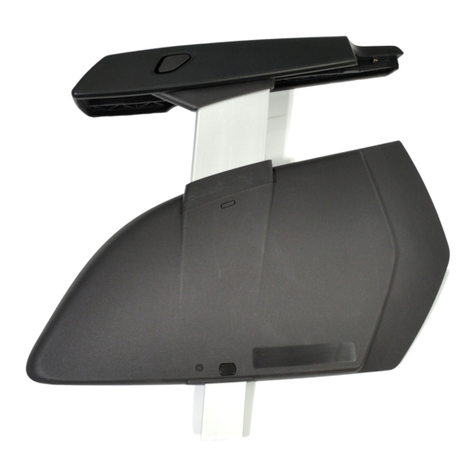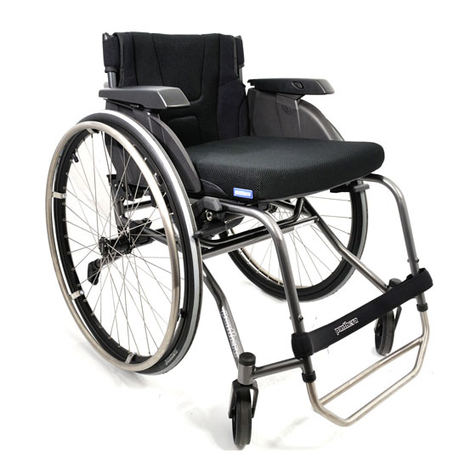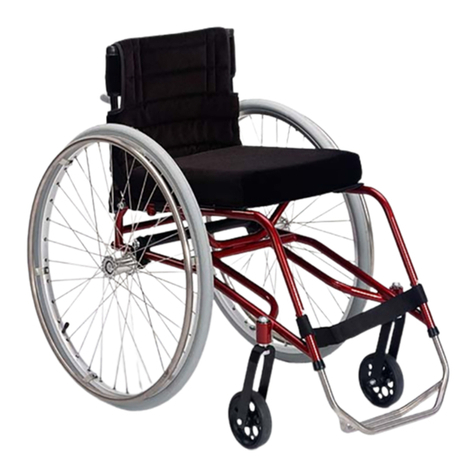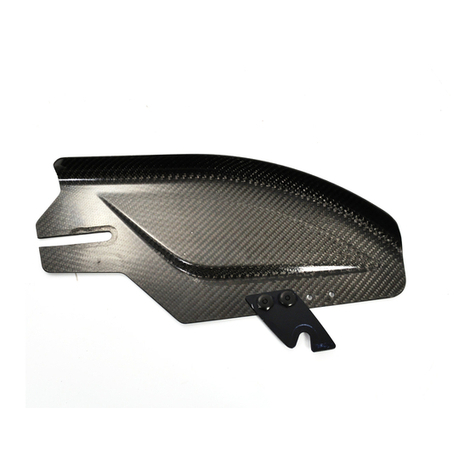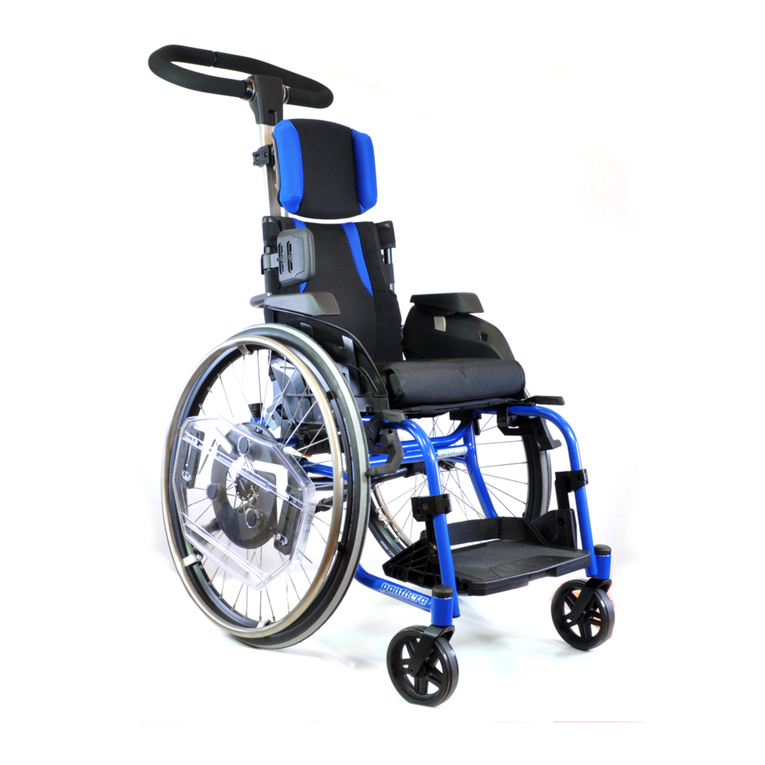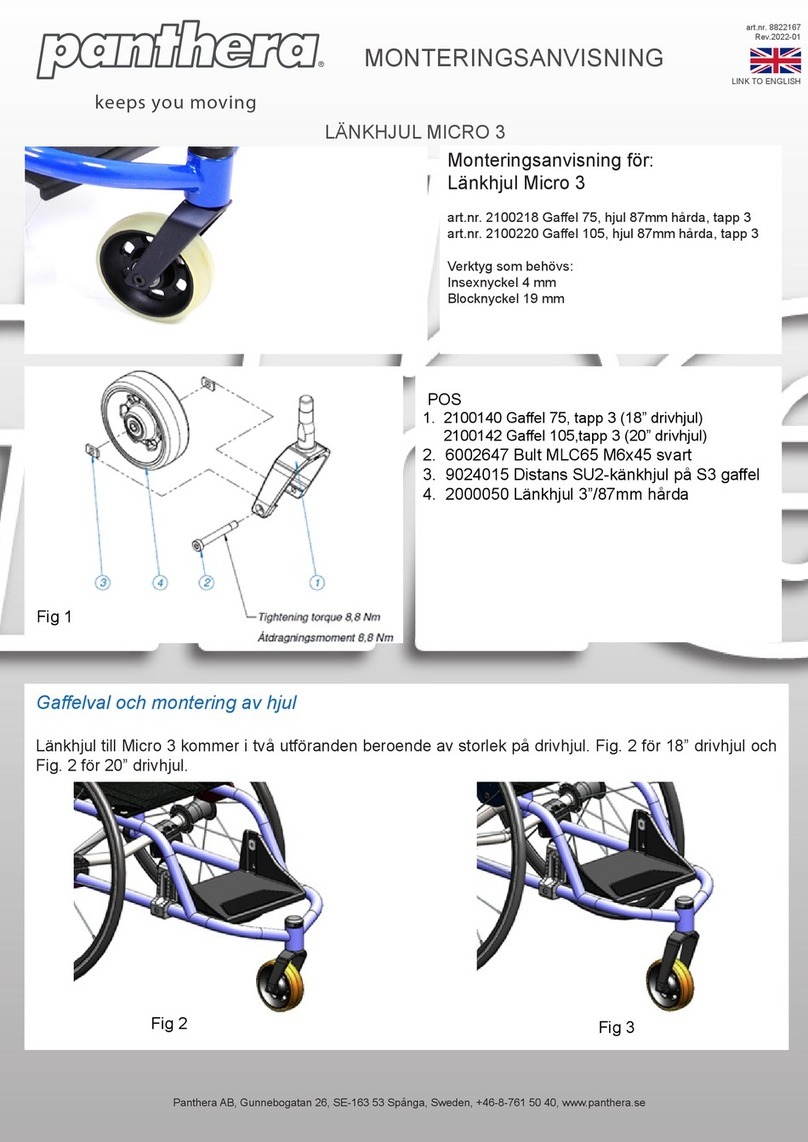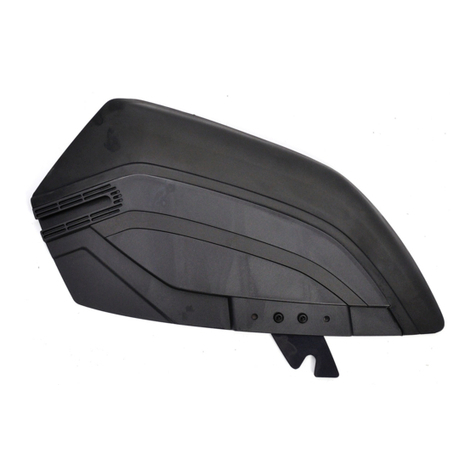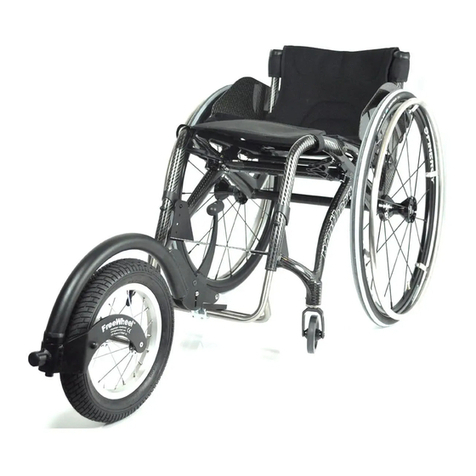
Instructions for use S2 Swing Instructions for use S2 Swing
910
Maintenance
Your Panthera is constructed to be virtually maintenance free. A few parts do require
regular checking however. (Naturally you should clean and check the chair more often
if you use it in more extreme environments such as in sand or salt water.)
Once a month you should:
Wipe the chair chassis over with car shampoo or washing-up liquid and a damp
cloth. If very dirty you can use a degreasing agent. Lubricate all moveable parts
with a universal lubricant (5-56, WD-40) after cleaning.
Clean the caster fork casing (between the wheel and the fork). Hair and dust col-
lect here which can damage the bearing. Loosen the nut using key no. 10 while
holding the bolt with key no. 10. Remove the bolt and then the wheel. Clean the
washers between the wheel and the fork and wipe the outside of the wheel bearing
with a cloth. Drop some oil into each bearing. Reassemble the parts.
Lubricate the rear wheel axles. Remove the wheel and distribute some drops of
oil over the axle. You should do this more often if you drive in rain, sand, salt and
slush or if you rarely remove the wheels.
Pump up the tyres. The tyres can be pumped by screwing the top off the valve and
filling with air using an appropriate valve adapter. The tyre can take 8 kg of
pressure.
Check that all the screws and nuts are securely fastened.
Check that the chair has not been damaged. If damage has occurred, contact us
immediately at Panthera Production AB.
Twice a year you should:
Lubricate the ball bearings for the brakes with some drops of oil.
Lubricate the bearings in the joints of the backrest. Remove the nut using cap key
no. 10 and hold the bolt still with key no. 10. Lubricate the bearings with some
drops of oil.
Wash the seat upholstery, the back upholstery and the cushion cover in 40 degrees
machine wash when necessary.
Guarantee and lifetime
The life of a Panthera depends on how much wear and tear it is exposed to and how
thorough you are with maintenance.
Guarantee: We offer a seven year factory guarantee on the chassis. For other parts there
is a guarantee of 12 months.
Max. weight: 36, 39, 42 cm 100 kilos, 45 cm 125 kilos.
•
•
•
•
•
•
•
•
•
Safety
A Panthera wheelchair is designed to be as easy to drive as possible and because of this
it reacts quickly to the actions you perform. If you perform the wrong actions the chair
can tip backwards if you don’t have anti-tips. The chair can potentially tip up and it is
not possible to issue a warning regarding all the circumstances in which that might occur.
The most important safety measures you can take include ensuring that you have tested
the chair thoroughly and spend time practicing your wheelchair technique.
If you have any questions about wheelchair technique you should contact the person who
prescribed the chair/your therapist. If they are unable to help you, please do not hesitate
to contact us at Panthera Production AB. We have a total of over 100 years’ experience of
daily use of wheelchairs. We would like to include some points here that may be helpful
for your safety.
Balance and tipping capacity
The position of the rear wheels, the angle and the adjustment of the backrest uphol-
stery are the most significant factors affecting the wheelchair’s tendency to tip. After
adapting your chair you should check that you feel safe with the balance of the chair.
If you feel unsure, you should use anti-tips or move the rear wheels further back.
The tipping capacity of the chair is also affected by: hanging a bag on the backrest,
leaning/stretching backwards, worn tyres, poorly pumped tyres and unforeseen chan-
ges in the surface you are driving on.
Warning! The chair can tip up on inclined surfaces when adapted in certain ways so use
anti-tips or move the rear wheels further back if you feel unsure of the chair’s stability.
Brakes
If you use our high brakes you should take care not to knock the brake with
your fingers when pushing on the pushrims.
If you use high brakes and wish to perform a sideways transfer to or from your
Panthera, it is important that you are able to lift yourself over the brake to avoid
sitting on it or getting caught on it.
If you use the single hand brake and are able to stand up, you should be careful
not to open the brakes by mistake with the back of your leg.
Remember that the brakes do not work as effectively on tyres with poor air
pressure or on worn tyres.
If you change to a new brand of tyre you should always check the brakes since
the dimensions may be different.
The brakes are designed as parking brakes and not for braking when in motion.
•
•
•
•
•
•
•
•


